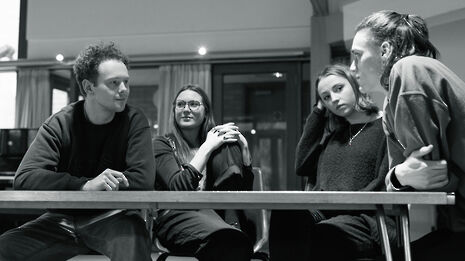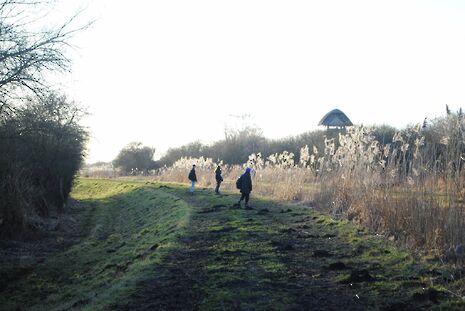Review: Fen
“Graceful and deftly executed with a light, sepia-toned touch, Fen is certainly not a play to be missed,” writes Rose Aitchison, impressed with the overall execution of this production of myth and meta-narrative

Fen, this week’s ADC main show directed by Louis Rogers is, ultimately, a story about stories. A tale about the human need to mythologise and how landscape shapes these stories and the people they are told by. Adapted by the cast from a collection of short stories by Daisy Johnson, Fen is truly a masterful and delicate balancing of the relationship between man and nature.
The play’s interest in this relationship is clear from the get-go, as the stage is filled with a neatly and tightly packed set, oddly reminiscent of an Ikea show home, with added buckets of fen water, mud and reeds. Characters scramble over and under different layers of furniture and screening, reflecting the twisting, murky nature of the plot.
The plot in question is an intergenerational mix of stories, some of which seems to be fables and some more believable. The audience are left fundamentally, not only asking themselves how the various vignettes all come together, but also to what extent the story is ‘true’. We are presented with fantastical stories which are the stuff of dreams, slightly odd stories (the stuff of playground gossip) and stories which could feasibly happen to anyone. But then again, upon leaving the theatre, we are forced to ponder if all of these stories are tales that could actually happen to people living in the Fens - if a house really could fall in love with a girl, if a man really could have his soul swallowed by an albatross, if a woman could give birth to a fox on a mouldy narrowboat.

This interest in the ambiguous relationship between the real and the fictional is particularly dubious in the Fen landscape, and further explored by the soundscapes created by Chris Lazenbatt. The sound in this production washes over the set and into the audience, blurring the line constantly between the diegetic (what the characters can hear) and the non-diegetic, casting the line between solid reality and fictional embellishment into unfamiliar and unclear territory.
The use of projection, both of British Pathé-style footage of pond and Fen life, and original footage of the cast shot by cinematographer Frank Martin, is extremely worthy of commendation. The mix of cinema and live action is a difficult medium and Fen manages to pull it off gracefully.
"At the heart of Fen's cohesiveness and success is Louis Rogers' natural direction, which flows so well that it feels barely perceptible"
Fen is truly an ensemble piece with a tight-knit cast of such a consistently high standard that it feels almost churlish to single out any particular actors for acclaim. However, special mention must go to Emma Corrin, who transitions seamlessly between characters and displayed a touching vulnerability in her performance, and also, to Benedict Clarke, whose portrayal of the dark and brooding Arch sliced through the other characters’ preference to sweep anxieties under the rug.

At the heart of Fen's cohesiveness and success is Louis Rogers' natural direction, which flows so well that it feels barely perceptible and utterly effortless for almost the whole performance. The set, designed by Evelyn Whorrall-Campbell and lighting, designed by Ana Pluskoska, complements Rogers' direction beautifully, allowing for a slick and effective use of the sometimes inelegant concept of the multi-area stage.
My only real reservation about Fen would perhaps be that, as a play that centres so much around intimacy and community, it perhaps would have been better placed in a more intimate venue than the ADC. That said, the ADC perhaps does lend to Fen the opportunity for the fourth wall to be broken, adding to this exploration of metanarrative. The overall effect of this kind of staging is one which is quite cinematic, placing the audience as a separate entity from the performers, there to sit comfortably and to have a story told to them.
Graceful and deftly executed with a light, sepia-toned touch, Fen is certainly not a play to be missed
 News / CUP announces funding scheme for under-represented academics19 December 2025
News / CUP announces funding scheme for under-represented academics19 December 2025 News / SU reluctantly registers controversial women’s soc18 December 2025
News / SU reluctantly registers controversial women’s soc18 December 2025 News / Cambridge welcomes UK rejoining the Erasmus scheme20 December 2025
News / Cambridge welcomes UK rejoining the Erasmus scheme20 December 2025 Features / Should I stay or should I go? Cambridge students and alumni reflect on how their memories stay with them15 December 2025
Features / Should I stay or should I go? Cambridge students and alumni reflect on how their memories stay with them15 December 2025 Film & TV / Timothée Chalamet and the era-fication of film marketing21 December 2025
Film & TV / Timothée Chalamet and the era-fication of film marketing21 December 2025









